Comparative Analysis of Aerosol Vertical Characteristics over the North China Plain Based on Multi-Source Observation Data
Abstract
1. Introduction
2. Experiment
2.1. Sites and Campaigns
2.2. Supporting Data
2.2.1. Aircraft Instruments
2.2.2. Ground Observation Instruments
2.2.3. Satellite Remote Sensing
2.2.4. Other Data
3. Results
3.1. Airborne Measured Aerosol Optical Properties
3.2. Airborne Measured Aerosol Optical Properties

3.3. Comparison of Multi-Source Retrieved AOD
4. Conclusions
Author Contributions
Funding
Data Availability Statement
Acknowledgments
Conflicts of Interest
References
- Zhang, Q.; Streets, D.G.; He, K.; Wang, Y.; Richter, A.; Burrows, J.P.; Uno, I.; Jang, C.J.; Chen, D.; Yao, Z.; et al. NOx emission trends for China, 1995–2004: The view from the ground and the view from space. J. Geophys. Res. 2007, 112, D22306. [Google Scholar] [CrossRef]
- Wang, F.; Li, Z.; Ren, X.; Jiang, Q.; He, H.; Dickerson, R.R.; Dong, X.; Lv, F. Vertical distributions of aerosol optical properties during the spring 2016 ARIAs airborne campaign in the North China Plain. Atmos. Chem. Phys. 2018, 18, 8995–9010. [Google Scholar] [CrossRef]
- Zhang, R.; Wang, Y.; Li, Z.; Wang, Z.; Dickerson, R.R.; Ren, X.; He, H.; Wang, F.; Gao, Y.; Chen, X.; et al. Vertical profiles of cloud condensation nuclei number concentration and its empirical estimate from aerosol optical properties over the North China Plain. Atmos. Chem. Phys. 2022, 22, 14879–14891. [Google Scholar] [CrossRef]
- Wang, Y.; Li, Z.; Zhang, Y.; Du, W.; Zhang, F.; Tan, H.; Xu, H.; Fan, T.; Jin, X.; Fan, X. Characterization of aerosol hygroscopicity, mixing state, and CCN activity at a suburban site in the central North China Plain. Atmos. Chem. Phys. 2018, 18, 11739–11752. [Google Scholar] [CrossRef]
- Kim, D.H.; Sohn, B.J.; Nakajima, T.; Takamura, T.; Takemura, T.; Choi, B.C.; Yoon, S.C. Aerosol optical properties over east Asia determined from ground-based sky radiation measurements. J. Geophys. Res. 2004, 109, 127–142. [Google Scholar] [CrossRef]
- Chameides, W.L.; Yu, H.; Liu, S.C.; Bergin, M.; Zhou, X.; Mearns, L.; Wang, G.; Kiang, C.S.; Saylor, R.D.; Luo, C. Case Study of the Effects of Atmospheric Aerosols and Regional Haze on Agriculture: An Opportunity to Enhance Crop Yields in China through Emission Controls? Proc. Natl. Acad. Sci. USA 1999, 96, 13626–13633. [Google Scholar] [CrossRef]
- Bellouin, N.; Boucher, O.; Haywood, J.; Reddy, M.S. Global estimate of aerosol direct radiative forcing from satellite measurements. Nature 2005, 438, 1138–1141. [Google Scholar] [CrossRef] [PubMed]
- Nair, V.S.; Babu, S.S.; Moorthy, K.K.; Sharma, A.K.; Marinoni, A.; Ajai. Black carbon aerosols over the Himalayas: Direct and surface albedo forcing. Tellus Ser. B-Chem. Phys. Meteorol. 2013, 65, 129–133. [Google Scholar] [CrossRef]
- Horvath, H. Estimation of the average visibility in central Europe. Atmos. Environ. 1995, 29, 241–246. [Google Scholar] [CrossRef]
- Ramanathan, V.; Crutzen, P.J. New Directions: Atmospheric Brown “Clouds”. Atmos. Environ. 2003, 37, 4033–4035. [Google Scholar] [CrossRef]
- Moorthy, K.K.; Nair, V.S.; Babu, S.; Satheesh, S. Spatial and vertical heterogeneities in aerosol properties over oceanic regions around India: Implications for radiative forcing. Q. J. R. Meteorol. Soc. 2009, 135, 2131–2145. [Google Scholar] [CrossRef]
- Lawrence, M.G.; Lelieveld, J. Atmospheric pollutant outflow from southern Asia: A review. Atmos. Chem. Phys. 2010, 10, 11017–11096. [Google Scholar] [CrossRef]
- Sun, Y.; Jiang, Q.; Xu, Y.; Ma, Y.; Zhang, Y.; Liu, X.; Li, W.; Wang, F.; Li, J.; Wang, P. Aerosol characterization over the North China Plain: Haze life cycle and biomass burning impacts in summer. J. Geophys. Res. Atmos. 2016, 121, 2508–2521. [Google Scholar] [CrossRef]
- Han, T.; Xu, W.; Chen, C.; Liu, X.; Wang, Q.; Li, J.; Zhao, X.; Du, W.; Wang, Z.; Sun, Y. Chemical apportionment of aerosol optical properties during the Asia-Pacific Economic Cooperation summit in Beijing, China. J. Geophys. Res. Atmos. 2016, 120, 12281–12295. [Google Scholar] [CrossRef]
- Babu, S.S.; Nair, V.S.; Gogoi, M.M.; Moorthy, K.K. Seasonal variation of vertical distribution of aerosol single scattering albedo over Indian sub-continent: RAWEX aircraft observations. Atmos. Environ. 2016, 125, 312–323. [Google Scholar] [CrossRef]
- Li, Z.; Ying, Z.; Jie, S.; Li, B.; Jin, H.; Dong, L.; Li, D.; Peng, W.; Wei, L.; Lei, L. Remote sensing of atmospheric particulate mass of dry PM2.5 near the ground: Method validation using ground-based measurements. Remote Sens. Environ. 2016, 173, 59–68. [Google Scholar] [CrossRef]
- Zhao, P.; Yin, Y.; Xiao, H. The Effects of Aerosol on Development of Thunderstorm Electrification: A Numerical Study. Atmos. Res. 2015, 153, 376–391. [Google Scholar] [CrossRef]
- Li, Z.; Wang, Y.; Guo, J.; Zhao, C.; Cribb, M.C.; Dong, X.; Fan, J.; Gong, D.; Huang, J.; Jiang, M. East asian study of tropospheric aerosols and their impact on regional clouds, precipitation, and climate (EAST-AIRCPC). J. Geophys. Res. Atmos. 2019, 124, 13026–13054. [Google Scholar] [CrossRef]
- Li, Z.; Rosenfeld, D.; Fan, J. Aerosols and their impact on radiation, clouds, precipitation, and severe weather events. In Oxford Research Encyclopedia of Environmental Science; Oxford University Press: Oxford, MI, USA, 2017. [Google Scholar]
- Li, Z.; Guo, J.; Ding, A.; Liao, H.; Liu, J.; Sun, Y.; Wang, T.; Xue, H.; Zhang, H.; Zhu, B. Aerosol and boundary-layer interactions and impact on air quality. Natl. Sci. Rev. 2017, 4, 810–833. [Google Scholar] [CrossRef]
- Haywood, J.; Boucher, O. Estimates of the direct and indirect radiative forcing due to tropospheric aerosols: A review. Rev. Geophys. 2000, 38, 513–543. [Google Scholar] [CrossRef]
- Lau, K.M.; Kim, M.K.; Kim, K.M. Asian summer monsoon anomalies induced by aerosol direct forcing: The role of the Tibetan Plateau. Clim. Dyn. 2006, 26, 855–864. [Google Scholar] [CrossRef]
- Liu, J.; Zheng, Y.; Li, Z.; Cribb, M. Analysis of cloud condensation nuclei properties at a polluted site in southeastern China during the AMF-China Campaign. J. Geophys. Res. Atmos. 2011, 116, D00K35. [Google Scholar] [CrossRef]
- Anderson, T.L.; Masonis, S.J.; Covert, D.S.; Ahlquist, N.C.; Howell, S.G.; Clarke, A.D.; McNaughton, C.S. Variability of aerosol optical properties derived from in situ aircraft measurements during ACE-Asia. J. Geophys. Res. Atmos. 2003, 108, D23. [Google Scholar] [CrossRef]
- John, M.L.; Philip, B.R.; Jeffrey, S.R.; Jens, R.; Beat, S.; Duane, A.A.; Omar, T.; Robert, C.L.; Lorraine, A.R.; Brent, N.H.; et al. Airborne Sun photometer measurements of aerosol optical depth and columnar water vapor during the Puerto Rico Dust Experiment and comparison with land, aircraft, and satellite measurements. J. Geophys. Res. 2003, 108, D19. [Google Scholar] [CrossRef]
- Sun, Y.; Du, W.; Fu, P.; Wang, Q.; Li, J.; Ge, X.; Zhang, Q.; Zhu, C.; Ren, L.; Xu, W. Primary and secondary aerosols in Beijing in winter: Sources, variations and processes. Atmos. Chem. Phys. 2016, 16, 8309–8329. [Google Scholar] [CrossRef]
- Jiang, Q.; Sun, Y.; Wang, Z.; Yin, Y. Aerosol composition and sources during the Chinese Spring Festival: Fireworks, secondary aerosol, and holiday effects. Atmos. Chem. Phys. 2015, 15, 6023–6034. [Google Scholar] [CrossRef]
- Wang, Q.; Sun, Y.; Xu, W.; Du, W.; Zhou, L.; Tang, G.; Chen, C.; Cheng, X.; Zhao, X.; Ji, D. Vertically resolved characteristics of air pollution during two severe winter haze episodes in urban Beijing, China. Atmos. Chem. Phys. 2018, 18, 2495–2509. [Google Scholar] [CrossRef]
- Garland, R.M.; Schmid, O.; Nowak, A.; Achtert, P.; Wiedensohler, A.; Gunthe, S.S.; Takegawa, N.; Kita, K.; Kondo, Y.; Hu, M. Aerosol optical properties observed during Campaign of Air Quality Research in Beijing 2006 (CAREBeijing-2006): Characteristic differences between the inflow and outflow of Beijing city air. J. Geophys. Res. Atmos. 2009, 114, 1065–1066. [Google Scholar] [CrossRef]
- Dong, Z.; Li, Z.; Yu, X.; Cribb, M.; Li, X.; Dai, J. Opposite long-term trends in aerosols between low and high altitudes: A testimony to the aerosol–PBL feedback. Atmos. Chem. Phys. 2017, 17, 7997–8009. [Google Scholar] [CrossRef]
- Barbaro, E.; Vilà-Guerau de Arellano, J.; Krol, M.; Holtslag, A. Impacts of aerosol shortwave radiation absorption on the dynamics of an idealized convective atmospheric boundary layer. Bound.-Layer Meteorol. 2013, 148, 31–49. [Google Scholar] [CrossRef]
- Ge, B.; Wang, Z.; Lin, W.; Xu, X.; Li, J.; Ji, D.; Ma, Z. Air pollution over the North China Plain and its implication of regional transport: A new sight from the observed evidences. Environ. Pollut. 2018, 234, 29–38. [Google Scholar] [CrossRef] [PubMed]
- Wang, L.; Li, P.; Yu, S.; Mehmood, K.; Li, Z.; Chang, S.; Liu, W.; Rosenfeld, D.; Flagan, R.C.; Seinfeld, J.H. Predicted impact of thermal power generation emission control measures in the Beijing-Tianjin-Hebei region on air pollution over Beijing, China. Sci. Rep. 2018, 8, 934. [Google Scholar] [CrossRef]
- Anderson, T.L.; Covert, D.S.; Marshall, S.F.; Laucks, M.L.; Charlson, R.J.; Waggoner, A.P.; Ogren, J.A.; Caldow, R.; Holm, R.L.; Quant, F.R. Performance Characteristics of a High-Sensitivity, Three-Wavelength, Total Scatter/Backscatter Nephelometer. J. Atmos. Ocean. Technol. 2009, 13, 967. [Google Scholar] [CrossRef]
- Anderson, T.L.; Ogren, J.A. Determining Aerosol Radiative Properties Using the TSI 3563 Integrating Nephelometer. Aerosol Sci. Technol. 1998, 29, 57–69. [Google Scholar] [CrossRef]
- Bond, T.C.; Anderson, T.L.; Campbell, D. Calibration and Intercomparison of Filter-Based Measurements of Visible Light Absorption by Aerosols. Aerosol Sci. Technol. 1999, 30, 582–600. [Google Scholar] [CrossRef]
- Sheridan, P.J.; Arnott, W.P.; Ogren, J.A.; Andrews, E.; Atkinson, D.B.; Covert, D.S.; Moosmüller, H.; Petzold, A.; Schmid, B.; Strawa, A.W. The Reno Aerosol Optics Study: An Evaluation of Aerosol Absorption Measurement Methods. Aerosol Sci. Technol. 2005, 39, 1–16. [Google Scholar] [CrossRef]
- Wang, Y.; Zhao, C.; Dong, Z.; Li, Z.; Hu, S.; Chen, T.; Tao, F.; Wang, Y. Improved retrieval of cloud base heights from ceilometer using a non-standard instrument method. Atmos. Res. 2018, 202, 148–155. [Google Scholar] [CrossRef]
- Zhao, C.; Wang, Y.; Wang, Q.; Li, Z.; Wang, Z.; Liu, D. A new cloud and aerosol layer detection method based on micropulse lidar measurements. J. Geophys. Res. Atmos. 2014, 119, 6788–6802. [Google Scholar] [CrossRef]
- O’neill, N.; Eck, T.; Smirnov, A.; Holben, B.; Thulasiraman, S. Spectral discrimination of coarse and fine mode optical depth. J. Geophys. Res. Atmos. 2003, 108, D17. [Google Scholar] [CrossRef]
- Zhang, Y.; Li, Z. Remote sensing of atmospheric fine particulate matter (PM2.5) mass concentration near the ground from satellite observation. Remote Sens. Environ. 2015, 160, 252–262. [Google Scholar] [CrossRef]
- Ångström, A. The parameters of atmospheric turbidity. Tellus 1964, 16, 64–75. [Google Scholar] [CrossRef]
- Kaufman, Y.J.; Fraser, R.S. The effect of smoke particles on clouds and climate forcing. Science 1997, 277, 1636–1639. [Google Scholar] [CrossRef]
- Fukuda, S.; Nakajima, T.; Takenaka, H.; Higurashi, A.; Kikuchi, N.; Nakajima, T.Y.; Ishida, H. New approaches to removing cloud shadows and evaluating the 380 nm surface reflectance for improved aerosol optical thickness retrievals from the GOSAT/TANSO-Cloud and Aerosol Imager. J. Geophys. Res. Atmos. 2013, 118, 13520–13531. [Google Scholar] [CrossRef]
- Li, C.; Marufu, L.T.; Dickerson, R.R.; Li, Z.; Wen, T.; Wang, Y.; Wang, P.; Chen, H.; Stehr, J.W. In situ measurements of trace gases and aerosol optical properties at a rural site in northern China during East Asian Study of Tropospheric Aerosols: An International Regional Experiment 2005. J. Geophys. Res. Atmos. 2007, 112, D22S04. [Google Scholar] [CrossRef]
- Bergin, M.; Cass, G.; Xu, J.; Fang, C.; Zeng, L.; Yu, T.; Salmon, L.; Kiang, C.; Tang, X.; Zhang, Y. Aerosol radiative, physical, and chemical properties in Beijing during June 1999. J. Geophys. Res. Atmos. 2001, 106, 17969–17980. [Google Scholar] [CrossRef]
- Garland, R.M.; Yang, H.; Schmid, O.; Rose, D. Aerosol optical properties in a rural environment near the mega-city Guangzhou, China: Implications for regional air pollution and radiative forcing. Atmos. Chem. Phys. 2008, 8, 5161–5186. [Google Scholar] [CrossRef]
- Hamonou, E.; Chazette, P.; Balis, D.; Dulac, F.; Schneider, X.; Galani, E.; Ancellet, G.; Papayannis, A. Characterization of the vertical structure of Saharan dust export to the Mediterranean basin. J. Geophys. Res. Atmos. 1999, 104, 22257–22270. [Google Scholar]
- Xu, D.; Wang, Y.; Zhu, R. Atmospheric environmental capacity and urban atmospheric load in mainland China. Sci. China Earth Sci. 2018, 61, 33–46. [Google Scholar] [CrossRef]
- Miao, Y.; Liu, S. Linkages between aerosol pollution and planetary boundary layer structure in China. Sci. Total Environ. 2019, 650, 288–296. [Google Scholar] [CrossRef]
- Gamage, N.; Hagelberg, C. Detection and analysis of microfronts and associated coherent events using localized transforms. J. Atmos. Sci. 1993, 50, 750–756. [Google Scholar] [CrossRef]
- Li, X.; Quan, J.; Wang, F.; Sheng, J.; Gao, Y.; Zhao, D.; Cheng, Z. Evaluation of the method for planetary boundary layer height retrieval by lidar and its application in Beijing. Chin. J. Atmos. Sci. 2018, 42, 435–446. [Google Scholar]
- Nozaki, K. Mixing depth model using hourly surface observations. USAF Environ. Tech. Appl. Cent. Rep. 1973, 7053, 25. [Google Scholar]
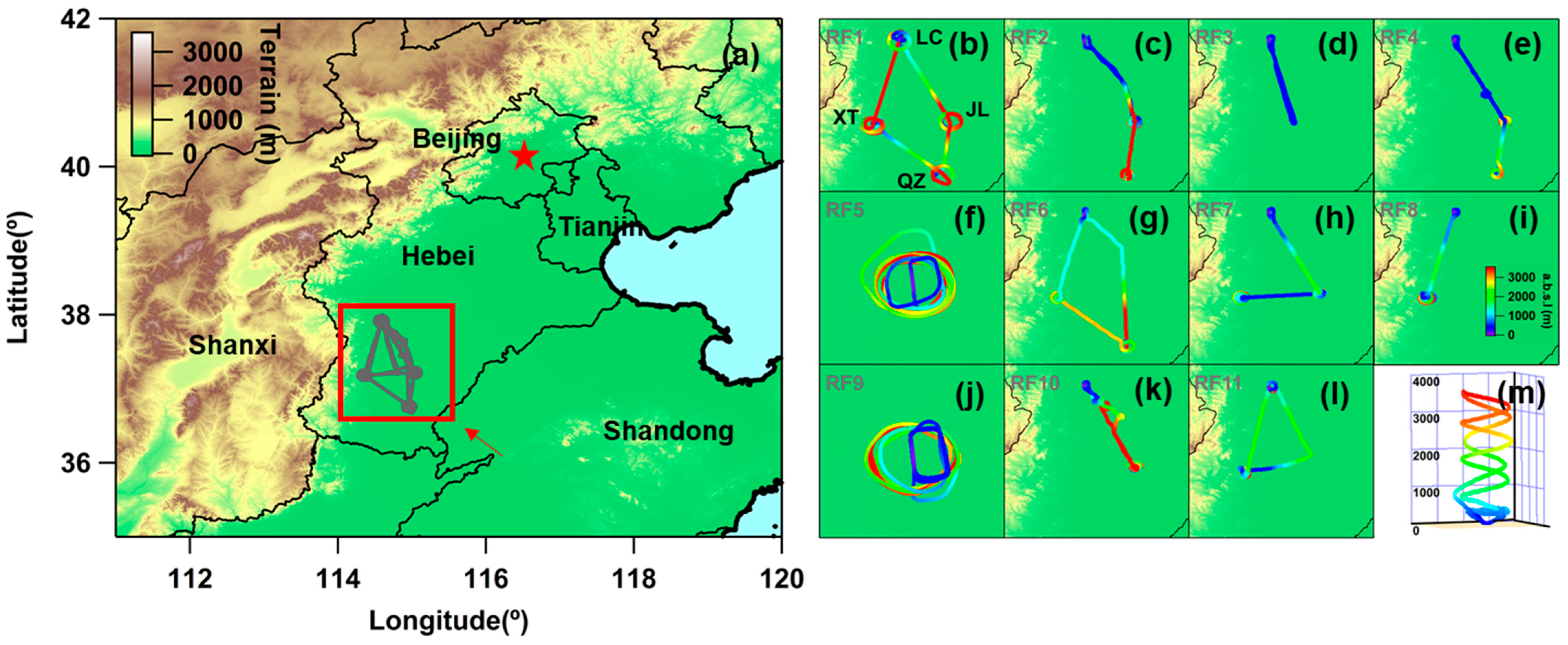

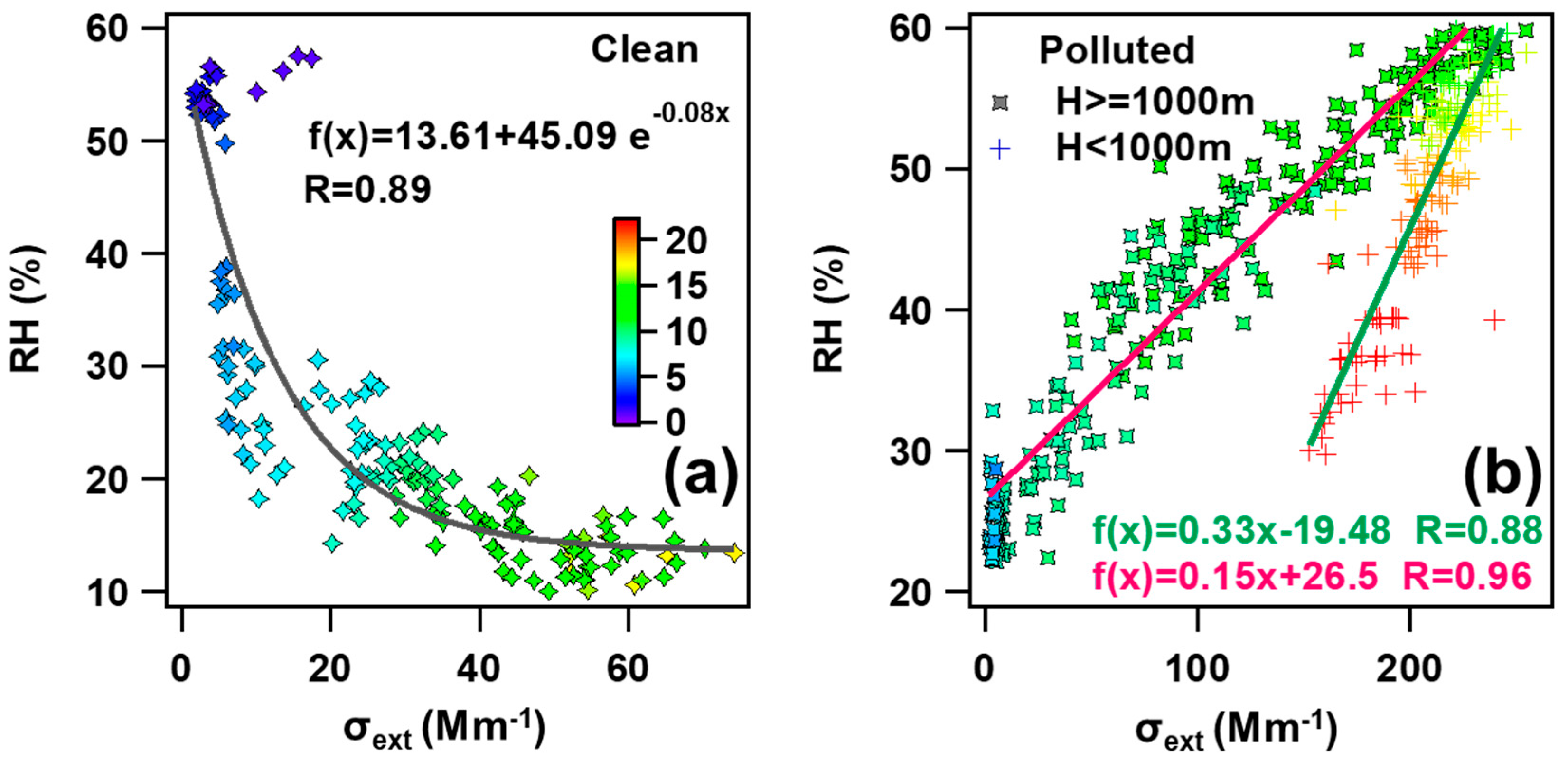

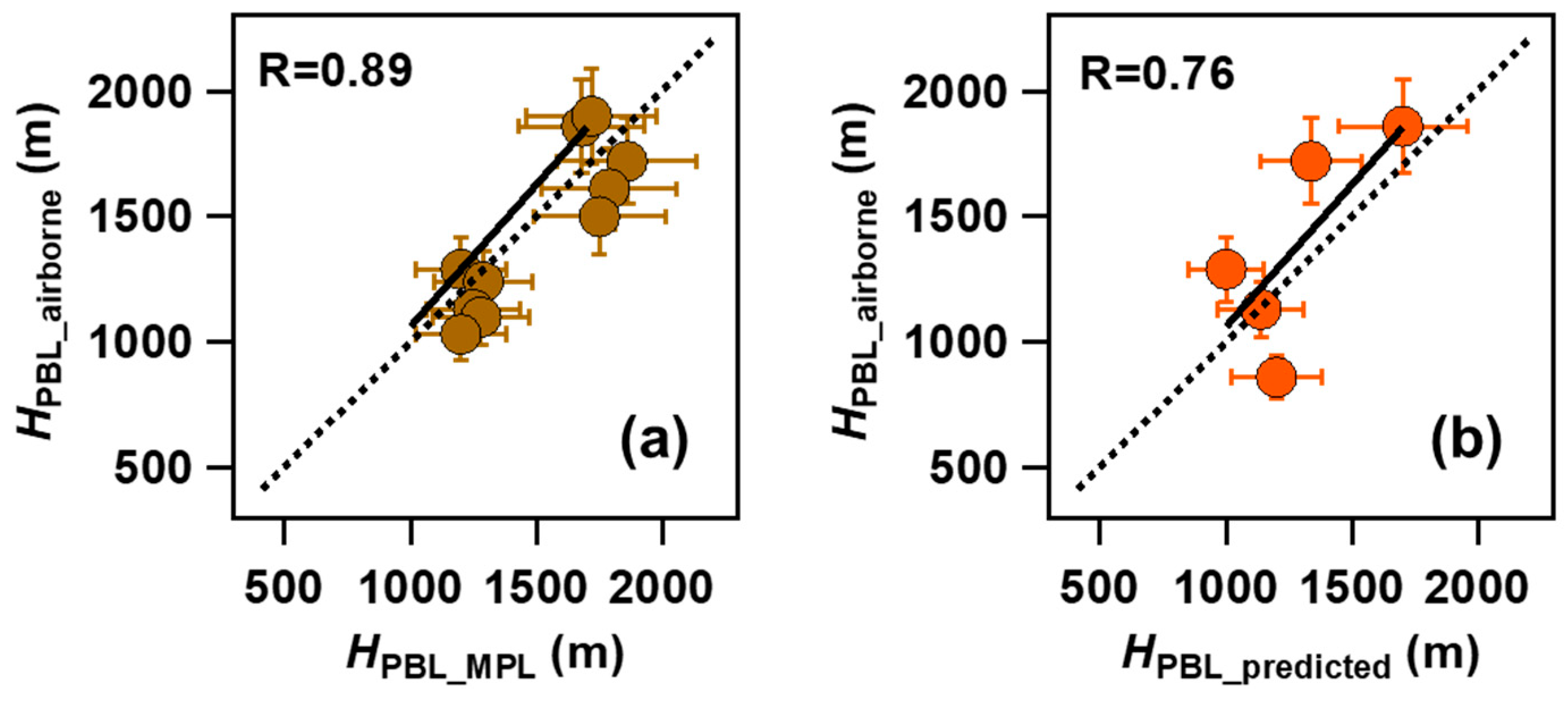
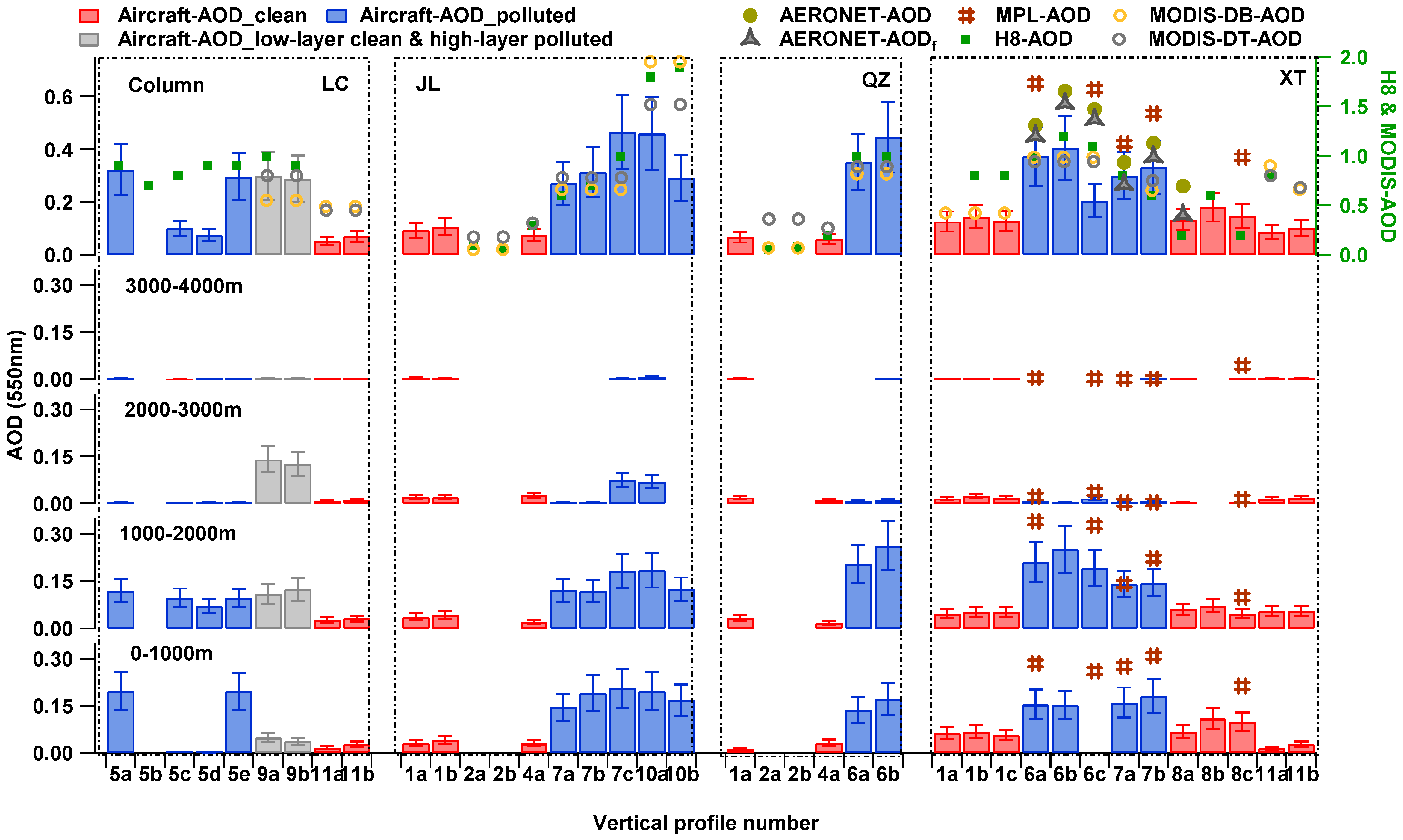

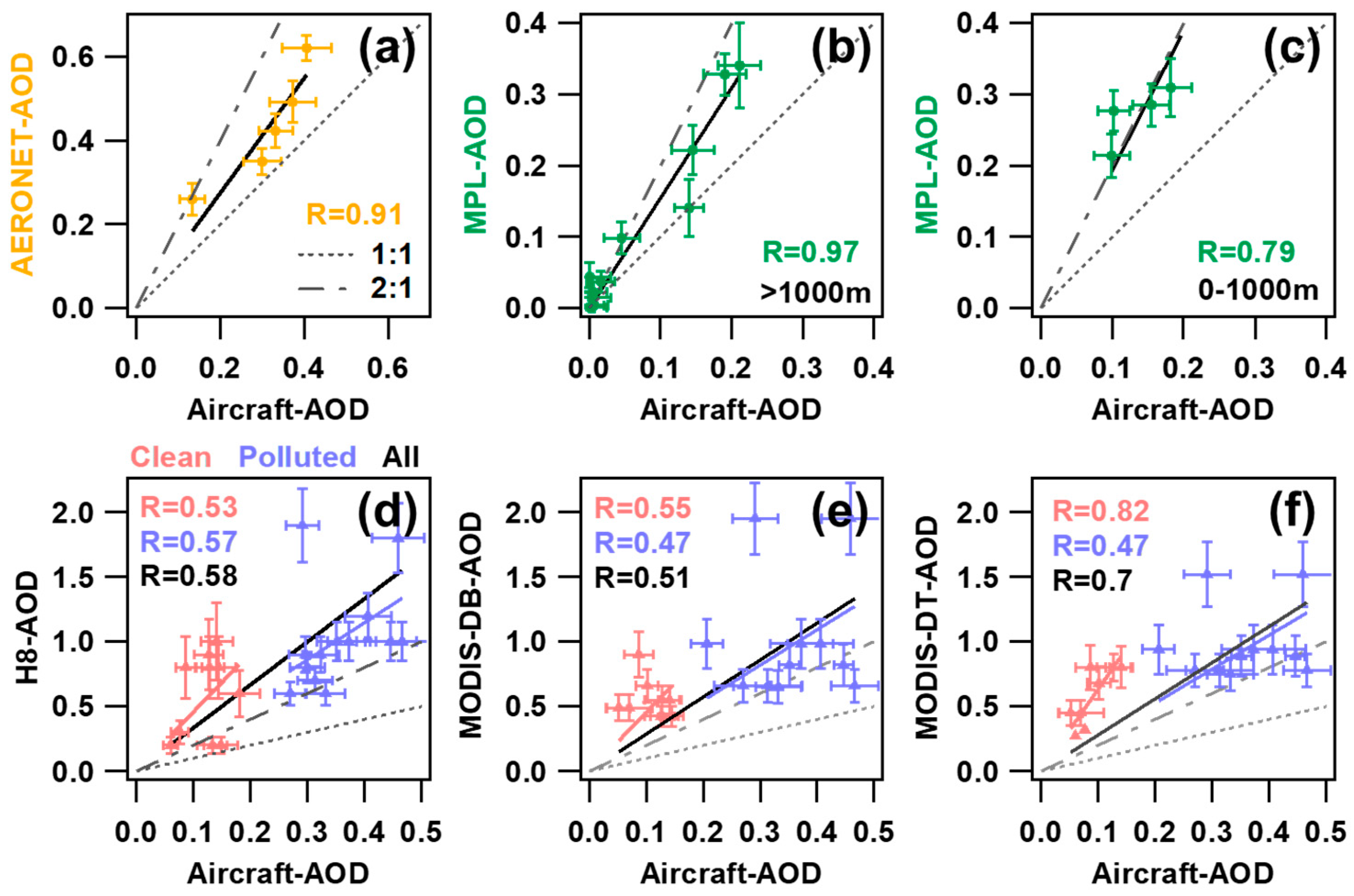
| Experiment name | Aerosol Atmosphere Boundary-Layer Cloud (A2BC) |
| Experimental region | Hebei Province, China |
| IOP experiment duration | 8 May to 11 June 2016 |
| Aircraft | Y-12 research aircraft |
| Flight altitude | 0.3~3.8 km above sea level |
| Total flights | 11 |
| Primary airborne instruments | Nephelometer, PSAP, CWIP, etc. |
| Primary ground-based instruments | MPL, CIMEL, etc. |
| NO. | Date | Spiral Region and Time Range (UTC) | Maximum Altitude (m) | Profile Type | |||
|---|---|---|---|---|---|---|---|
| LC | JL | QZ | XT | ||||
| RF1 | 20160508 | a: 3:20–3:43 b: 2:56–3:20 | a: 4:00–4:18 | a: 4:40–4:55 b: 5:06–5:23 c: 5:23–5:42 | 3751 | CPs | |
| RF2 | 20160515 | a: 4:42–5:05 b: 5:05–5:23 | a: 5:58–6:18 b: 5:41–5:58 | 3679 | Invalid data | ||
| RF3 | 20160516 | 467 | Invalid data | ||||
| RF4 | 20160517 | a: 1:47–2:00 | a: 2:18–2:29 | 2924 | CPs | ||
| RF5 | 20160519 | a: 7:43–8:02 b: 8:02–8:12 c: 8:29–8:35 d: 8:36–8:47 e: 8:47–9:08 | 3733 | PPs | |||
| RF6 | 20160521 | a: 5:00–5:16 b: 4:39–5:00 | a: 5:51–6:06 b: 5:33–5:51 c: 6:06–6:16 | 3242 | PPs | ||
| RF7 | 20160528 | a: 4:28–4:40 b: 4:40–4:54 c: 4:54–5:00 | a: 3:18–3:33 b: 3:53–4:11 | 3101 | PPs | ||
| RF8 | 20160528 | a: 9:15–9:30 b: 8:50–8:56 c: 9:39–9:54 | 3130 | PPs | |||
| RF9 | 20160602 | a: 5.47–6.07 b: 6:07–6:33 | 3591 | Low-layer clean High-layer polluted | |||
| RF10 | 20160606 | a: 3:03–3:19 b: 2:43–3:03 | 3178 | PPs | |||
| RF11 | 20160611 | a: 5:12–5:27 b: 5.45–5.48 | a: 3:55–4:08 b: 4:24–4:44 | 3203 | CPs | ||
Disclaimer/Publisher’s Note: The statements, opinions and data contained in all publications are solely those of the individual author(s) and contributor(s) and not of MDPI and/or the editor(s). MDPI and/or the editor(s) disclaim responsibility for any injury to people or property resulting from any ideas, methods, instructions or products referred to in the content. |
© 2024 by the authors. Licensee MDPI, Basel, Switzerland. This article is an open access article distributed under the terms and conditions of the Creative Commons Attribution (CC BY) license (https://creativecommons.org/licenses/by/4.0/).
Share and Cite
Wang, F.; Li, Z.; Jiang, Q.; Ren, X.; He, H.; Tang, Y.; Dong, X.; Sun, Y.; Dickerson, R.R. Comparative Analysis of Aerosol Vertical Characteristics over the North China Plain Based on Multi-Source Observation Data. Remote Sens. 2024, 16, 609. https://doi.org/10.3390/rs16040609
Wang F, Li Z, Jiang Q, Ren X, He H, Tang Y, Dong X, Sun Y, Dickerson RR. Comparative Analysis of Aerosol Vertical Characteristics over the North China Plain Based on Multi-Source Observation Data. Remote Sensing. 2024; 16(4):609. https://doi.org/10.3390/rs16040609
Chicago/Turabian StyleWang, Fei, Zhanqing Li, Qi Jiang, Xinrong Ren, Hao He, Yahui Tang, Xiaobo Dong, Yele Sun, and Russell R. Dickerson. 2024. "Comparative Analysis of Aerosol Vertical Characteristics over the North China Plain Based on Multi-Source Observation Data" Remote Sensing 16, no. 4: 609. https://doi.org/10.3390/rs16040609
APA StyleWang, F., Li, Z., Jiang, Q., Ren, X., He, H., Tang, Y., Dong, X., Sun, Y., & Dickerson, R. R. (2024). Comparative Analysis of Aerosol Vertical Characteristics over the North China Plain Based on Multi-Source Observation Data. Remote Sensing, 16(4), 609. https://doi.org/10.3390/rs16040609








